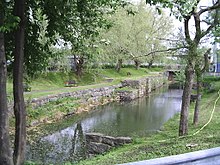Göta Kanal [ˈjøːˈta kaˈnɑːl] is a semi-artificial waterway through the Östergötland and Västergötland provinces in Sweden. It connects the Baltic Sea to Sweden's two greatest lakes, Vättern and Vänern. From Vänern, Trollhätte kanal and Göta älv (a natural river) make up a passage to the Atlantic Ocean, forming a 390-kilometre (240 mi) waterway from coast to coast.
An important industrial transport route throughout the 19th century, it is now used mainly by leisure craft.
Understand
[edit]
- See also: Nordic history
The idea to build a canal across Sweden was discussed as early as 1516. However, it would take almost 300 years until the idea was put into action. On the 12 of April 1810 the architect Baltzar von Platen was given the task of constructing the canal. The purpose was to shorten transportation between the eastern and western coast of Sweden, by having ships navigate through Sweden rather than around it. Thereby the ships would also be able to avoid paying Danish tolls when passing Öresund. It was also considered a way to kick-start modernisation of Sweden. The budget of the project was 24 million Swedish riksdaler, which would correspond to some 2,5 billion kr in modern terms, by far the most expensive public construction project in Sweden up until that point. The construction of the canal involved some 58,000 labourers, and lasted some 22 years. The canal was finally inaugurated on 26 September 1832, shortly after the death of the chief-architect von Platen.
The canal faced competition from railways from the 1850s and forward. These had the advantages of being faster, did not clog traffic around different locks, and were operable during winter when the canal was frozen. In 1857 the Öresund toll, which had justified the project in the first place, was abolished. The most notable industrial effect of the canal was the foundation of the engineering company Motala Verkstad, and thereby also the city of Motala, in 1822. Ironically they were early producers of locomotives and railway rolling stock.
In spite of competition from railways, freight on the canal kept growing until the 1930s, with spikes during the World Wars. While Sweden was not belligerent in any of the wars, ocean traffic were restricted due to mining and blockades, and fuel rationing restricted road traffic.
From the 1950s, road traffic made the freight transport obsolete, and today the canal is mainly used for recreational tours and tourism, and is visited by some 2 million people every year. The 1981 comedy film Göta Kanal and its sequels revived interest in the canal.
Göta Kanal connects the Baltic sea with the lakes Roxen, Boren, Vättern, Viken (which is the canal's most elevated point), and Vänern, the largest lake in Europe outside of Russia. Along the canal there are 58 locks. There are today automated, except for one lock in Tåtorp and one in Borensberg, which are still hand-operated. By Ljungsbro and Borensberg there are two aqueducts.
Route
[edit]The Östergötland section:
- 1 Söderköping — A small historical city which marks the point where Göta kanal meets the Baltic sea.
- 2 Linköping — With 100,000 inhabitants it is one of the larger cities in Sweden. Göta kanal passes through the countryside surrounding the city.
- 3 Motala — Located on the shores of lake Vättern, it is one of the cities most associated with Göta kanal.
The Västergötland section:
- 4 Karlsborg — A fortified city which, due to its more strategic location, is the "backup capital" of Sweden in case of an emergency.
- 5 Töreboda — Located at the intersection of Göta Kanal and Västra Stambanan, the railroad connecting Stockholm with Gothenburg.
- 6 Mariestad — A small but historical city with a cathedral.
The Göta Älvdal section:
- 7 Vänersborg — A historical city located on the shores of lake Vänern, known as the regional capital of Western Götaland County.
- 8 Trollhättan — It markes the point where Trollhälle kanal enters lake Vänern.
- 9 Lilla Edet — A small locality known as the location of the medieval city of Lödöse.
- 10 Ale — A suburb of Gothenburg.
- 11 Gothenburg — The second largest city in Sweden, and located at the mouth of Göta älv into the Atlantic ocean.
Travelling with your own vessel
[edit]
When travelling with your own vessel you will have to pay a lock-fee of 80 to 180 kr, depending of the size of the lock. The locks are generally operating from 09:00 to 18:00. During the winter season, which starts in late September and continues until May first, the channel is closed, but during pre- and post-season locks can be passed if booked in advance. If you are not used to being locked, make sure that you thoroughly prepare and read the available information. Always follow the instructions of the lock service staff.
Travelling with a canalboat
[edit]If you do not have a vessel of your own you can travel with one of the canalboats. These usually make shorter trips from one of the larger cities along the canal, and go ashore by different notable destinations, such as Karlsborg fortress in Karlsborg. If you want a full channel cruise these are offered between Stockholm and Gothenburg. The ships M/S Juno and M/S Wilhelm Tham travel the length of the channel in four days. Nights are spent in a dock. You can book a ticket via their website, per telephone (☏ +46 31-80 63 159) or by e-mail (bookings@gotacanal.se).
A four day cruise with M/S Juno is 13,300 kr per person in a double cabin, including meals and tours.
See also
[edit]- Boating on the Baltic Sea
- Saimaa Canal - connecting Lake Saimaa with the Gulf of Finland, modelled on Göta Kanal and opened in 1856.

